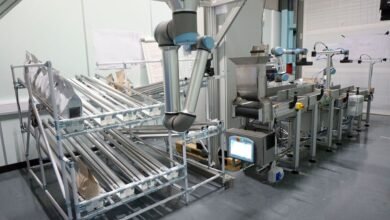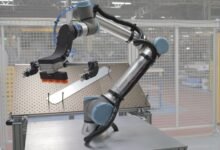Risk Assessment: Complex, Challenging, Absolutely Required

Peeling back the complexity onion one more layer and we find ISO/TS 15066 (RIA TR R15.606) where a study with 100 people (adults) resulted in Biomechanical Thresholds for Quasi-static pressures allowable on various body parts. The table also shows forces and transient contacts, however these values are derived from literature studies. For transient contacts showing “not applicable”, there is no data available.
And let’s not forget Stop Categories, a classification of stops, described in IEC-60204-1 (NFPA79 in North America):
1. Stop Category 0, stopping by immediate removal of power
2. Stop Category 1, a controlled stop until full stop is achieved and then power is removed.
3. Stop Category 2, a controlled stop with power available.
And finally, for the purposes of this article, Functional Safety Performance Levels are specified for safety functions in both ISO 10218 parts 1 and 2. Functional safety is covered by ISO 13849 and IEC 62061. Within ISO 13849, the probability of a dangerous failure occurring per hour (PFHD), where the smaller or lower PFHd values are better safety performance
Other points of consideration to determine the risk estimation in the risk assessment process:
1. Severity of harm
2. Probability of occurrence of harm
a. Exposure (frequency and duration) to the hazard
b. Probability of a hazardous event
c. Technical and human possibilities to avoid the harm.
I think we have established complex and challenging – now let’s understand why a risk assessment is absolutely required throughout factory automation, and in robot applications in particular.
Misconceptions
Unfortunately there are misconceptions that have become widespread in the industry, that need to be properly managed:
1. “Cobots are all the safety you need”. Incorrect. Cobots alone are not collaborative, only cobot applications can be collaborative. Properly applied, robots with collaborative safety functions can be used safely in applications after a risk assessment and measurements to ensure that the cobot safety functions are properly set.
2. “If the cobot hits you, you will be fine”. Incorrect. Contact to the head and eyes is not allowed. And even if contact technically OK according to ISO/TS 15066 (RIA TR R15.606), a bump from a robot application could cause injury and pain.
3. “It’s a cobot, so the robot will be fine if it hits something”. Incorrect. Repeated collision (impacts) could cause premature wear of the robot.
Manufacturing in general and robotics specifically can be relatively safe – follow this link for a report from the Bureau of Labor Statistics
The burden is on the whole industry (robot manufacturers, integrator and user) to maintain the safety interest and performance. But we must continuously improve it year over year. And a thorough risk assessment is the front-line tool to help both identify and then reduce these risks to people in manufacturing.
Now the good news about the risk assessment process: At it’s core, it is a simple loop:
1. Determine limits
2. Identify hazards
3. Estimate risks
4. Evaluate risks based on severity, exposure, probability and avoidability.
5. Mitigate risks by design (layout, selection of application components), then next by technical means (guards and safety device) and lastly with administrative measures (signage, training, procedures & work instructions).
6. Repeat as necessary.
And there are resources and tools available to help companies get started in creating a sustainable, effective risk assessment process to improve the safety throughout manufacturing.
A3, The Association for Advancing Automation, has a comprehensive suite of products, publications and classes about robot safety and risk assessments.






